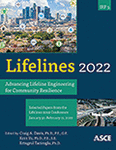Selection of Multihazard-Based Damage Scenarios for the Los Angeles Water Transmission Network
Publication: Lifelines 2022
ABSTRACT
Earthquake damage scenarios are required to support design and analysis of spatially distributed infrastructure systems. In this paper, we develop a computationally efficient set of damage scenarios for the Los Angeles water transmission system that considers ground motion and liquefaction. Each damage scenario describes one possible realization of damage to the pipe network and includes the corresponding multihazard scenario and an associated adjusted annual occurrence probability. Each damage scenario, which specifies the damage state of each pipe in the network, is defined to be physically realistic and consistent with the associated multihazard scenario. Together, when probabilistically combined, the set of damage scenarios with their occurrence probabilities matches the probabilistic hazard and component damage distributions. The scenarios are selected to be small in number so that subsequent analysis is efficient. We combine ideas from recently developed methods to generate sets of multihazard scenarios as well as damage scenarios for analysis of spatially distributed infrastructure systems. The method applied in this paper involves simulating multiple hazards and a number of respective damage scenarios, and using optimization to select a subset of damage scenarios and assign adjusted occurrence probabilities.
Get full access to this article
View all available purchase options and get full access to this chapter.
REFERENCES
Bagriacik, A., Davidson, R., Hughes, M., Bradley, B., and Cubrinovski, M. (2018). “Comparison of statistical and machine learning approaches to modeling earthquake damage to water pipelines.” Soil Dyn. Earthquake Eng. 112: 76–88. https://doi.org/10.1016/j.soildyn.2018.05.010.
Brown, N. J., Gearhart, J. L., Jones, D. A., Nozick, L. K., Romero, N., and Xu, N. (2013, December). Multi-objective optimization for bridge retrofit to address earthquake hazards. In 2013 Winter Simulations Conference (WSC) (pp. 2475–2486). IEEE.
Brown, N. J., Gearhart, J. L., Jones, D. A., Nozick, L. K., Romero, N., and Xu, N. (2011). Optimizing the Selection Of Scenarios for Loss Estimation In Transportation Networks. Sandia National Lab.(SNL-NM), Albuquerque, NM (United States).
Cubrinovski, M., Hughes, M., Bradley, B., Mccahon, I., Mcdonald, Y., Simpson, H., Cameron, R., Christison, M., Henderson, B., Orense, R., and O’Rourke, T. (2011). Liquefaction Impacts on Pipe Networks engineering, University of Canterbury, New Zealand.
Davis, C. (2019a). Performance-based Seismic Design for LADWP Water System,.
Davis, C. A. (2019b). “A Proposed Performance Based Seismic Design Process for Lifeline Systems,” in Earthquake Geotechnical Engineering for Protection and Development of Environment and Constructions: Proc. 7th International Conference on Earthquake Geotechnical Engineering, (ICEGE 2019), CRC Press Balkema, pp 1986–1993.
Field, E., Arrowsmith, R., Biasi, G., Bird, P., Dawson, T., Felzer, K., Jackson, D., Johnson, K., Jordan, T. H., Madden, C., Michael, A., Milner, K., Page, M., Parsons, T., Powers, P. M., Shaw, B., Thatcher, W., Weldon, R., and Zeng, Y. (2014). Uniform California Earthquake Rupture Forecast, version 3 (UCERF3) -The time-independent model. Bull. Seismol. Soc. Am. 104(3): 1122–1180. https://doi.org/10.1785/0120130164.
Gearhart, J. L., Brown, N. J., Jones, D. A., Nozick, L. K., Romero, N., and Xu, N. (2011). Optimization of Scenario Construction for Loss Estimation in Lifeline Networks. Sandia National Lab. (SNL-NM), Albuquerque, NM (United States).
Gearhart, J., Brown, N., Jones, D., Nozick, L., Romero, N., and Xu, N. (2014). Optimization-based probabilistic consequence scenario construction for lifeline systems. Earthquake Spectra, 30(4), 1531–1551. https://doi.org/10.1193/092711EQS237M.
Han, Y., and Davidson, R. (2012). Probabilistic seismic hazard analysis for spatially distributed infrastructure, Earthquake Engineering and Structural Dynamics 41, 2141–2158. https://doi.org/10.1002/eqe.2179.
Jayaram, N., and Baker, J. (2010). Efficient sampling and data reduction techniques for probabilistic seismic lifeline risk assessment, Earthquake Eng. and Structural Dynamics 39, 1109–1131. https://doi.org/10.1002/eqe.988.
Kongar, I., Rossetto, T., and Giovinazzi, S. (2017). Evaluating simplified methods for liquefaction assessment for loss estimation. Nat. Hazards Earth Syst. Sci., 17(5): 781–800. https://doi.org/10.5194/nhess-17-781-2017.
Lanzano, G., Salzano, E., de Magistris, F. S., and Fabbrocino, G. (2014). “Seismic vulnerability of gas and liquid buried pipelines.” J. Loss Prev. Process Ind. 28 (Apr): 72–78. https://doi.org/10.1016/j.jlp.2013.03.010.
Manzour, H., Davidson, R. A., Horspool, N., and Nozick, L. K. (2016). Seismic hazard and loss analysis for spatially distributed infrastructure in Christchurch, New Zealand. Earthquake Spectra, 32(2), 697–712. https://doi.org/10.1193/041415EQS054M.
Miller, M., and Baker, J. (2015). Ground‐motion intensity and damage map selection for probabilistic infrastructure network risk assessment using optimization. Earthquake Engineering & Structural Dynamics, 44(7), 1139–1156. https://doi.org/10.1002/eqe.2506.
Petersen, M., Dawson, T., Chen, R., Cao, T., Wills, C., Schwartz, D., and Frankel, A. (2011). Fault displacement hazard for strike-slip faults. Bull. Seismol. Soc. Am., 101(2): 805–825. https://doi.org/10.1785/0120100035.
Powers, P. (2015). “GitHub - usgs/nshm-cous-2014: NSHM: Conterminous U.S. 2014.” Accessed June 1, 2018. https://github.com/usgs/nshm-cous-2014.
Soleimani, N., Davidson, R., Davis, C., O’Rourke, T., and Nozick, L. Multihazard scenarios for regional seismic risk assessment of spatially distributed infrastructure. Journal of Infrastructure Systems, in press.
SCG (Southern California Gas Company). (2001-2003). Liquefaction Susceptibility Maps. Prepared by William Lettis and Associates, Inc. for SCG.
Toprak, S., Nacaroglu, E., Koc, A., Van Ballegooy, S., Jacka, M., Torvelainen, E., and O’Rourke, T. (2017). Pipeline damage predictions in liquefaction zones using LSN, in 16th World Conference on Earthquake Engineering, 8–13 January, 2017, Santiago, Chile.
Zolfaghari, M., and Peyghaleh, E. (2016). “Development of optimization-based probabilistic earthquake scenarios for the city of Tehran.” Computers and Geosciences 86, 129–145. https://doi.org/10.1016/j.cageo.2015.10.003.
Information & Authors
Information
Published In
History
Published online: Nov 16, 2022
Authors
Metrics & Citations
Metrics
Citations
Download citation
If you have the appropriate software installed, you can download article citation data to the citation manager of your choice. Simply select your manager software from the list below and click Download.
